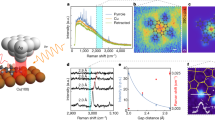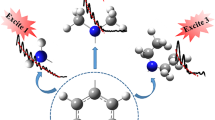Abstract
The selective excitation of molecular vibrations provides a means to directly influence the speed and outcome of chemical reactions. Such mode-selective chemistry1 has traditionally used laser pulses to prepare reactants in specific vibrational states2 to enhance reactivity3,4 or modify the distribution of product species5,6. Inelastic tunnelling electrons may also excite molecular vibrations7,8 and have been used to that effect on adsorbed molecules, to cleave individual chemical bonds9 and induce molecular motion10,11,12,13 or dissociation14,15,16,17. Here we demonstrate that inelastic tunnelling electrons can be tuned to induce selectively either the translation or desorption of individual ammonia molecules on a Cu(100) surface. We are able to select a particular reaction pathway by adjusting the electronic tunnelling current and energy during the reaction induction such that we activate either the stretching vibration of ammonia or the inversion of its pyramidal structure. Our results illustrate the ability of the scanning tunnelling microscope to probe single-molecule events in the limit of very low yield and very low power irradiation, which should allow the investigation of reaction pathways not readily amenable to study by more conventional approaches.




Similar content being viewed by others
References
Jortner, J., Levine, R. D. & Pullman, B. (eds) Mode Selective Chemistry (Kluwer Academic, Dordrecht, 1991)
Dai, H. L. & Ho, W. (eds) Laser Spectroscopy and Photochemistry on Metal Surfaces (World Scientific, Singapore, 1995)
Higgings, J., Conjusteau, A., Scoles, G. & Bernasek, S. L. State selective vibrational (2ν3) activation of the chemisorption of methane on Pt(111). J Chem. Phys. 114, 5277–5283 (2001)
Potter, E. D., Herek, J. L., Pedersen, S., Liu, Q. & Zewail, A. H. Femtosecond laser control of a chemical reaction. Nature 355, 66–68 (1992)
Sinha, A., Hsiao, M. C. & Crim, F. F. Controlling bimolecular reactions: Mode and bond selected reaction of water with hydrogen atoms. J. Chem. Phys. 94, 4928–4935 (1991)
Bronikowski, M. J., Simpson, W. R., Girard, B. & Zare, R. N. Bond-specific chemistry: OD:OH product ratios for the reactions H + HOD(100) and H + HOD(001). J. Chem. Phys. 95, 8647–8648 (1991)
Hansma, P. K. (ed.) Tunnelling Spectroscopy: Capabilities, Applications, and New Techniques (Plenum, New York, 1982)
Stipe, B. C., Rezaei, M. A. & Ho, W. Single-molecule vibrational spectroscopy and microscopy. Science 280, 1732–1735 (1998)
Ho, W. Inducing and viewing bond selected chemistry with tunneling electrons. Acc. Chem. Res. 31, 567–573 (1998)
Eigler, D. M., Lutz, C. P. & Rudge, W. E. An atomic switch realized with the scanning tunnelling microscope. Nature 352, 600–603 (1991)
Stipe, B. C., Rezai, M. A. & Ho, W. Coupling of vibrational excitation to the rotational motion of a single adsorbed molecule. Phys. Rev. Lett. 81, 1263–1266 (1998)
Komeda, T., Kim, Y., Kawai, M., Persson, B. N. J. & Ueba, H. Lateral hopping of molecules induced by excitation of internal vibration mode. Science 295, 2055–2058 (2002)
Bartels, L. et al. Atomic scale chemistry: Desorption of ammonia from Cu(111) induced by tunneling electrons. Chem. Phys. Lett. 313, 544–552 (1999)
Avouris, Ph. Manipulation of matter at the atomic and molecular level. Acc. Chem. Res. 28, 95–102 (1995)
Stipe, B. C. et al. Single-molecule dissociation by tunneling electrons. Phys. Rev. Lett. 78, 4410–4413 (1997)
Hla, S. W., Bartels, L., Meyer, G. & Rieder, K. H. Inducing all steps of a chemical reaction with the scanning tunneling microscope tip: Towards single molecule engineering. Phys. Rev. Lett. 85, 2777–2780 (2000)
Kim, Y., Komeda, T. & Kawai, M. Single-molecule reaction and characterization by vibrational excitation. Phys. Rev. Lett. 89, 126104 (2002)
Rust, H.-P., Buisset, J., Schweizer, E. K. & Cramer, L. High precision mechanical approach mechanism for a low temperature scanning tunneling microscope. Rev. Sci. Instrum. 68, 129–132 (1997)
Hertel, T., Wolf, M. & Ertl, G. UV photostimulated desorption of ammonia from Cu(111). J. Chem. Phys. 102, 3414–3430 (1995)
Hussla, I. et al. Infrared-laser-induced photodesorption of NH3 and ND3 adsorbed on single-crystal Cu(100) and Ag film. Phys. Rev. B 32, 3489–3501 (1985)
Prybyla, J. A., Heinz, T. F., Misewich, J. A., Loy, M. M. T. & Glownia, J. H. Desorption induced by femtosecond laser pulses. Phys. Rev. Lett. 64, 1537–1540 (1990)
Salam, G. P., Persson, M. & Palmer, R. E. Possibility of coherent multiple excitation in atom transfer with a scanning tunneling microscope. Phys. Rev. B 49, 10655–10662 (1994)
Lorente, N. & Persson, M. Theory of single molecule vibrational spectroscopy and microscopy. Phys. Rev. Lett. 85, 2997–3000 (2000)
Lorente, N. & Persson, M. Theoretical aspects of tunneling-current-induced bond excitation and breaking at surfaces. Faraday Discuss. 117, 277–290 (2000)
Acknowledgements
J.I.P. acknowledges research contracts ‘Marie Curie’ (EU) and ‘Ramon y Cajal’ (Ministerio de Ciencia y Tecnología). N.L. acknowledges support from ACI Jeunes Chercheurs, and the CNRS programme ‘Nano-Objet Individuel’. All calculations were performed at the Centre d'Informatique National de l'Enseignement Supérieur (CINES) and the Centre de Calcul Midi-Pyrénées (CALMIP).
Author information
Authors and Affiliations
Corresponding author
Ethics declarations
Competing interests
The authors declare that they have no competing financial interests.
Rights and permissions
About this article
Cite this article
Pascual, J., Lorente, N., Song, Z. et al. Selectivity in vibrationally mediated single-molecule chemistry. Nature 423, 525–528 (2003). https://doi.org/10.1038/nature01649
Received:
Accepted:
Issue Date:
DOI: https://doi.org/10.1038/nature01649
- Springer Nature Limited
This article is cited by
-
Scanning probe microscopy
Nature Reviews Methods Primers (2021)
-
Gradual collapse of nuclear wave functions regulated by frequency tuned X-ray scattering
Scientific Reports (2017)
-
Selective gating to vibrational modes through resonant X-ray scattering
Nature Communications (2017)
-
An analysis of oasis evolution based on land use and land cover change: A case study in the Sangong River Basin on the northern slope of the Tianshan Mountains
Journal of Geographical Sciences (2017)
-
Bond selectivity in electron-induced reaction due to directed recoil on an anisotropic substrate
Nature Communications (2016)





